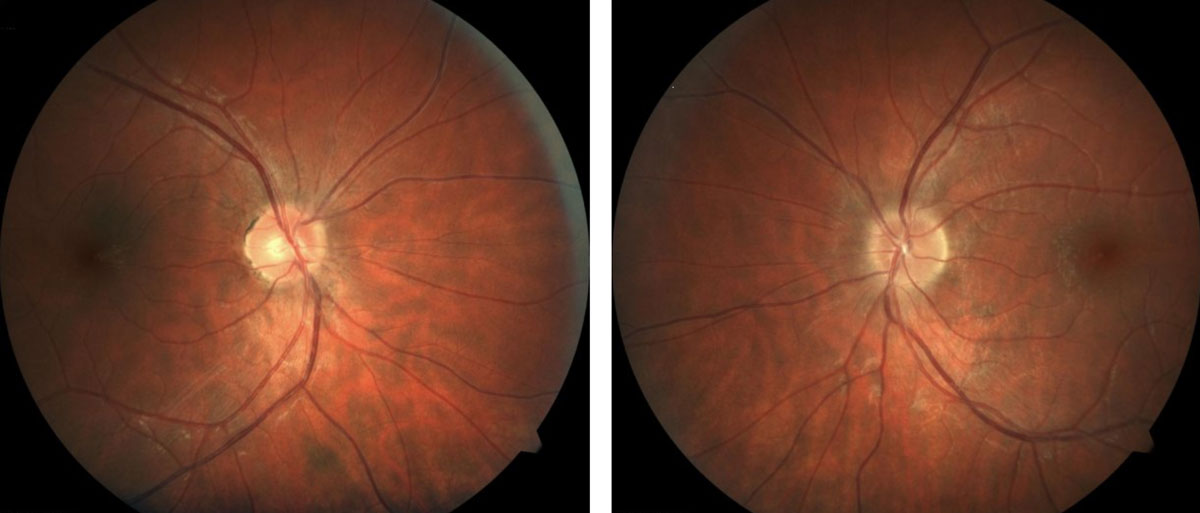 |
| Decreased metabolic demand may be one reason for the observed choroidal changes in eyes of MS patients. This individual shows irregular optic disc margins. Photo: Christopher L. Suhr. Click image to enlarge. |
With recent evidence suggesting widespread ocular pathology in multiple sclerosis (MS), the potentially debilitating disease has increasingly been researched in terms of involvement with the eye. MS has already been studied in patients for related changes in structure and microvascular alterations of the inner retina, but the outer retina has not received as much attention. As such, a new study in the Journal of Neuro-Ophthalmology assessed potential changes of the outer retina and choroid of MS patients with no optic neuritis (ON) history.
Included were 37 MS patients (72 eyes) and 74 healthy controls (148 eyes). Swept source OCT and swept source OCT angiography (OCT-A) were used to assess images for outer retinal thickness, choroid thickness, vessel density of the choriocapillaris and choroidal vascularity index. The MS patients showed reduced choriocapillaris vessel density and choroidal vascularity index. Neither outer retinal thickness nor choroid thickness was different between the two groups.
In the discussion of their findings, the study researchers highlight that previous work has proposed outer retinal dysfunction as a primary manifestation during progression of MS, but no consensus has been determined in outer retina alteration. Some OCT studies have showed both normal and abnormal outer retinal structure in MS patients. Functional examinations have concluded contradictory findings in outer retinal function compared with controls.
The observed vessel density decrease of the choriocapillaris and reduced choroidal vascularity index are both findings consistent with other research. The authors suggest that choroidal circulation abnormalities may be compatible with the lack of structural changes, potentially meaning MS effects present early at the level of choroidal circulation.
Since the choroid is crucial in transporting oxygen and nutrients to the outer retina, decreased blood perfusion of it may reflect structural and functional abnormalities of the retinal pigment epithelium and photoreceptor cells. The exact mechanism is unknown, but the authors suggest some possibilities. One is due to decreased metabolic demand, originating with the blood-retinal barrier that regulates small molecule regulation and restricts the passageway of cells and macromolecules from circulation. When inflammatory cells and mediators invade choroidal space, direct contact with the retinal pigment epithelium may trigger its overactivation. Thus, this affects photoreceptor cells negatively and in turn, contributing to outer retina impairment with resultant decreased need for oxygen and nutrients.
Another possibility is that decreased cerebral perfusion is reflected in choroidal circulation, potentially promoting ischemic brain lesion progression. Hypoperfusion with MS may in part be caused by elevated plasma endothelin-1 levels and reduced axonal activity. Elevated endothelin-1 levels lead to vasoconstriction and enhance sensitivity of vessels to other vasoconstrictors, which leads to axonal degeneration. Since the choroid is the most vascular of eye structures, the authors hypothesize vascular disorganization may be found in the choroid as well. From this, choroidal circulation impairment may reflect potential outer retina alteration.
Finally, the authors note their study’s potential for clinical use, explaining that “our findings provide deeper insight into the pathophysiology of MS, suggesting that swept source OCT-A could be used as screening patterns for detecting MS.”
Gao Y, Liu Y, Zhang Y, et al. Assessment of outer retina and choroid using swept source optical coherence tomography and angiography in patients with multiple sclerosis. J Neuro Opthalmol. August 25, 2023. [Epub ahead of print]. |

